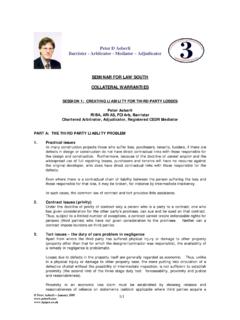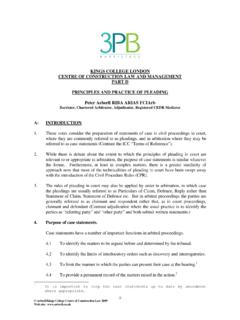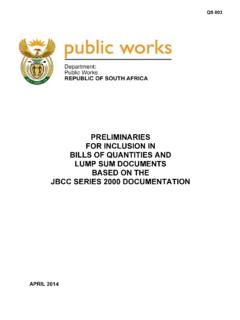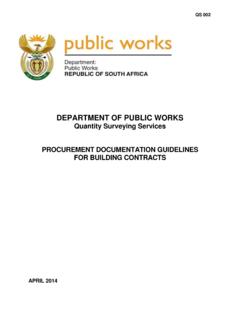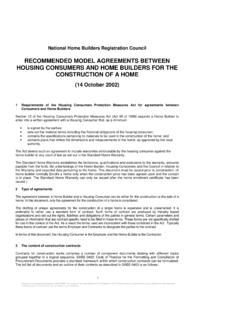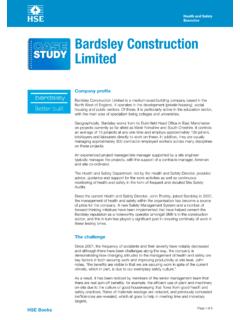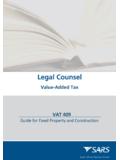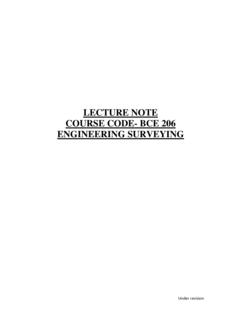Transcription of COURSE FOR BPP PROFESSIONAL EDUCATION ... - …
1 peter Aeberli September 2011 1 COURSE FOR BPP PROFESSIONAL EDUCATION construction LAW BASIC principles peter Aeberli RIBA, ARIAS, ACE, FCIArb, Barrister Chartered Arbitrator, Adjudicator, Registered CEDR Mediator TIME TABLE - : Introduction. - : The construction Process - Roles and Legal Relationships - The Statutory Context. - : Coffee. - : Obligations in Contract and Tort. - : Lunch. - : Obligations in Contract and Tort. - : construction Disputes and their resolution. - : Tea. - : Understanding construction Contracts and PROFESSIONAL Services Agreements. INTRODUCTION The purpose of this seminar is to introduce the basic principles of construction law, not to provide a detailed consideration of particular standard form contracts or contractual arrangements, or to give a detailed analysis of recent construction law cases.
2 construction law is not a separate branch of law, such as the law of trusts, or real property or family law. Rather it involves the application of well-understood legal principles , in particular the law of contract and tort, to a particular commercial activity, the procuring of construction projects. Further material relevant to the topics covered by these notes can be found at _____ peter Aeberli September 2011 1/1 COURSE FOR BPP PROFESSIONAL EDUCATION construction LAW BASIC principles SESSION 1: THE construction PROCESS ROLES AND LEGAL RELATIONSHIPS -THE STATUTORY CONTEXT peter Aeberli RIBA, ARIAS, ACE, FCIArb, Barrister Chartered Arbitrator, Adjudicator, Registered CEDR Mediator PART A: THE PROCUREMENT PROCESS 1. The nature and extent of construction activity construction activity extends from, at one extreme, the individual house for a private client to, at the other, new hospitals or shopping developments.
3 It encompasses buildings, engineering works, such as sewers and bridges, and major infrastructure projects, such as airports and trunk roads. Arguably, the defining characteristic of the construction process is that it concerns the procuring of purpose built solutions to client needs, not the purchase of off the shelf 2. The persons involved Those involved in the construction process include: - The client, the employer; - Design consultants principally architects and engineers (civil, structural, mechanical and electrical); - Quantity surveyors; - Contract administrators (employer s representatives); - CDM Co-ordinators (formerly planning supervisors) and principal contractors (see the construction (Design and Management) Regulations 2007 ( the CDM Regulations )); - Contractors, sub-contractors and specialist contractors ( specialists ).
4 - Regulatory authorities principally planning authorities (always a local authority) and building control authorities (usually, but not necessarily a local authority). - Specialist agencies, such as the Health and Safety Executive and the Environment Agency. There are, in addition, funders, purchasers and tenants, and users. 1 Lord Bingham at the KCCCL 1996 Conference suggests the following reasons for construction disputes. Project supplied is variable until finished, and price is fluid creates uncertainty and opportunity for argument. Long delivery, more possibility of changing circumstances. Complex products need detailed planning, greater possibility of error and incompleteness. Unusual number and range of participants, scope for misunderstanding and buck passing.
5 Large amounts of money at stake can make costly dispute resolution seem worthwhile. Non specific contact documentation, complex. A claims culture, gross inequality of commercial power and a tendency to plan for claims. peter Aeberli September 2011 1/23. The decision to build Those involved are the client and, in the case of a developer, its funders. The decision to build may involve consideration of other options evaluated in the light of the client s needs and requirements. Feasibility studies may be required, usually involving a design consultant and possibly a quantity surveyor or other financial advisor. 4. Typical stages of a construction project A typical construction project will involve the following stages (work stages) and numerous published plans of work, such as the RIBA Plan of Work, reflect these stages.
6 In practise, however some stages may overlap, or may do so for certain parts of the project. Feasibility The client s requirements and constraints on development are assessed in sufficient detail to decide whether to proceed with the project. If so, an initial (strategic) brief is prepared identifying requirements for and constraints on the project and covering matters such as location, function, quality, budget, programme, consultant roles and procurement route. At the end of this stage, the client will begin to assemble a consultant team. The range of consultants depends on the nature of the project and the procurement route. If the project is notifiable under the CDM Regulations, a CDM Co-ordinatator must, generally, be appointed by the client,2 as soon as is practical after initial design work or other preparation for construction work has begun Outline proposals A final (project) brief is prepared along with outline proposals for the project.
7 Outline development control approval (outline planning, landlord consents) may be sought at this stage. The British Property Federation views this stage as part of Feasibility. Final proposals Designs for the project and developed and costed in sufficient detail to enable detailed design to commence. Final development control approval (full planning approval) is, ordinarily, sought at the end of this stage. Detailed Design Although this stage is some times merged with Final proposals, it is important that all aspects of the design of the project are sufficiently developed and co-ordinated so that changes during subsequent work stages are minimised and production information (information for construction ) can be prepared. A design freeze is usually imposed at the end of this stage, and Building Regulation approval sought.
8 Production information Information is prepared showing how the project is to be constructed and remaining statutory (for instance, building control) and other approvals are obtained. Depending 2 The regulations only apply to clients: who in the COURSE or furtherance of a business (a) seeks or accepts the services of another which may be used in the carrying out of a project for him; or (b) carries out a project himself . peter Aeberli September 2011 1/3on the procurement method, production information may be prepared before or during the construction of the project. Where consultants prepare production information it generally (should!) comprise fully co-ordinated drawings, schedules and specifications. Depending on the procurement route, bills of quantities may also be produced.
9 Depending on the procurement method, detailed design and production information for parts of the project (works packages) may continue during construction of the project. Tender action Tender documentation is prepared and tenders obtained and appraised. The timing of this stage, and the work encompassed by tender, depends on the procurement method. The next stage, construction , cannot start until a principal contractor is appointed. The British Property Federation views all the stages between Feasibility and construction as the Pre- construction phase. construction The construction stage involves three principal stages, mobilisation, construction to completion (often referred to as practical completion), as well as work, including making good of defects, from practical completion up to final account (final certificate).
10 The employer s consultants may have inspection and certifying duties during this stage. If the project is notifiable under the CDM Regulations, a principal contractor must, generally, be appointed by the client before construction work starts. The interrelationship between the construction stage and the Pre- construction stage depends on the procurement route. PART B: LEGAL RELATIONSHIPS 1. Structuring legal relationships The structure of legal relationships adopted on a construction project depends partly on the chosen procurement and payment route and partly on the extent to which persons other than the client, who might suffer loss or damage if it is defective (such as funders and those who may acquire interests in the project on completion), are to be included in this structure.


